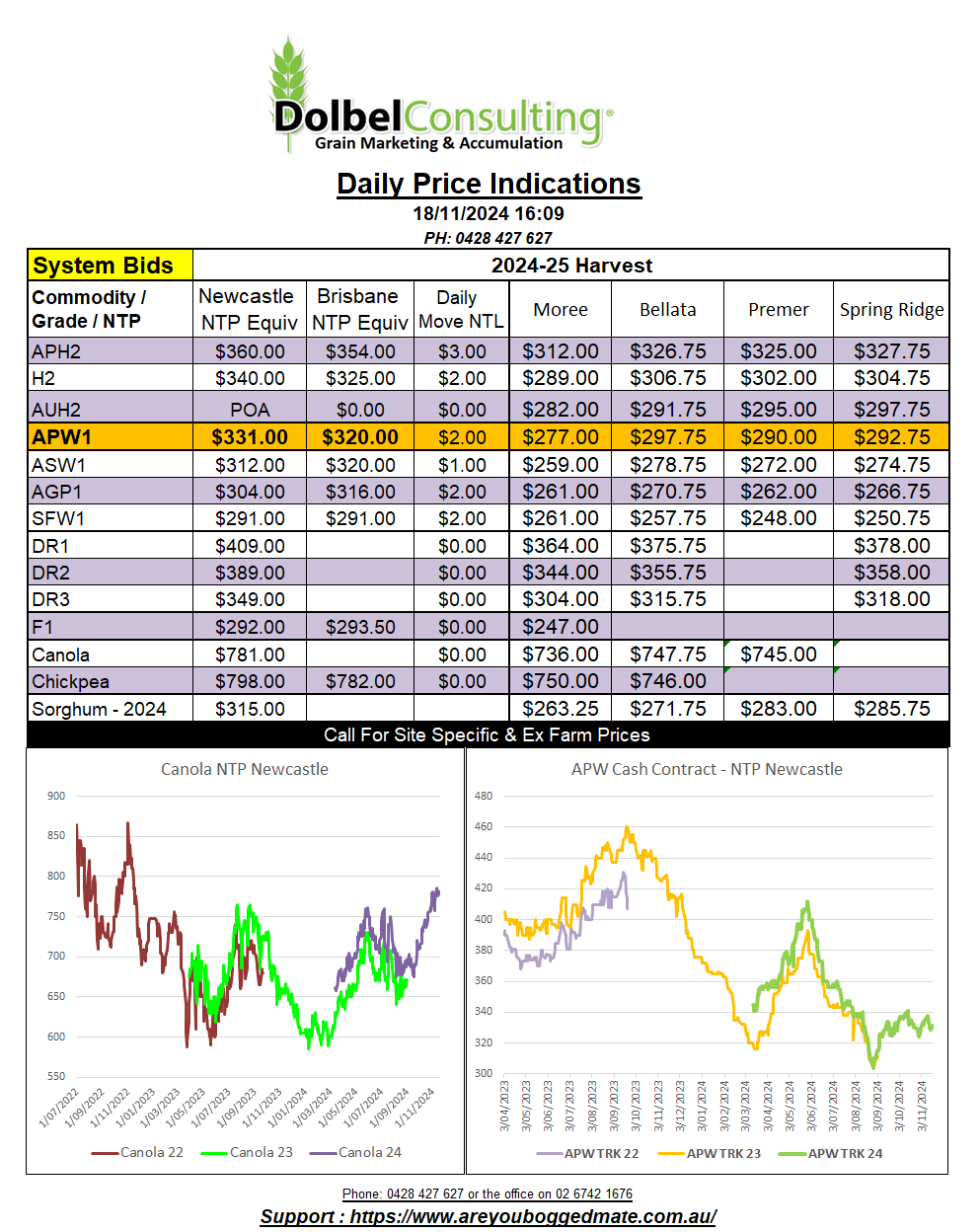18/11/24 Prices

With the US now off daylight saving time and Australia is on it, the time difference has shrunk. Being so far apart one might think this has little impact on price analysis, but I start to prepare this report at 6.30am. This is fine to get closing futures data, but the cash market reporting procedures are not as prompt as the futures markets. Thus reliable cash grain comparisons can sometimes lag a little and may not become available until later in the day. Not ideal but a fact of life unfortunately. This may not have much of an impact in a flat or rangebound market but during times of volatility it may make global price analysis more difficult in the mornings, especially if there is some disparity between futures and cash……god forbid.
Palm oil futures staged a recovery last night, up 116 on the nearby, just under AUD$40.00/t. This spurred a slight recovery in Chicago soybeans, the January contract closing +11c/bu (AUD$6.26). The real impact appears to be across the canola and rapeseed contracts. Paris rapeseed rallied €8.75 /tonne (AUD$14.28) in the Feb slot, Winnipeg canola gained C$21.50 (AUD$23.63) in the January slot.
The weaker AUD will help the conversions again today. The AUD touched a low of 64.44 and has only recovered 10-20pts over the last 6 hours.
The bounce in canola / rapeseed futures may give those with canola in store a marketing window at better prices on Monday, if the local trade follow the futures market higher. Last week we did see basis improvements against Winnipeg but fairly flat basis against Paris, which is promising. The big question is if the bounce in palm oil is a dead cat bounce or the start of a sustainable recovery.
Weekly (1-7 Nov) US soybean sales were back 24% from the previous week and the 4 week average. Weekly US sorghum sales were good, net 141.3kt, so much for Chinese importers easy up on purchases just yet. This is a marketing year weekly sales high for US sorghum, it’s all China. US wheat sales came in at just over 380kt, about the same as last weeks report, but down 17% on the 4 week average.
A mixed day with most producers pushing hard with harvest, trying to get as much off before the next rain event. Here on the Liverpool Plains we’ve been lucky to miss as many storms as we have. Those with winter crops already in the bin, or still weeks away from harvest, are probably looking for and inch or so to brighten up the summer crop and pasture, but with this years winter crop presenting exceptional yields it’d be a shame to see it ruined by rain.
Yields in wheat and barley continue to break local records, not just slightly but smashing them out of the oval. This is presenting storage issues for many, prompt demand ex farm or delivered end user / port isn’t great for premium, milling or feed grade wheat. The need to move chickpeas as quick has possible has strained the logistics capability of the trade and easy prompt supply has generally flattened the demand from the feed market.
When it comes to storing spillover, milling grades appear to be moving to the central storage system. This isn’t because the price is better at the silo, it’s not, it is simply because the producer stands to loose less taking milling grades to the system as opposed to APW / ASW.
For example H2 delivered Newcastle was indicated at $365 – $370 yesterday, or $325 ex farm. H2 delivered Graincorp Spring Ridge was bid $304.75, a difference of $20.25. SFW1 / ASW was bid at $315 – $320 delivered feedlot, trading at $300 XF. ASW / SFW1 delivered delivered Graincorp Spring Ridge was bid at $274.75 for ASW and $249.75 for SFW1. A difference of $25.25 for ASW or $50.25 for SFW1. The majority of the wheat coming off is H2 at present. Exceptional yields and a soft season has been great for yields but protein is generally between 10% and 12% for wheat. The trade is seeking 13.5% +.
